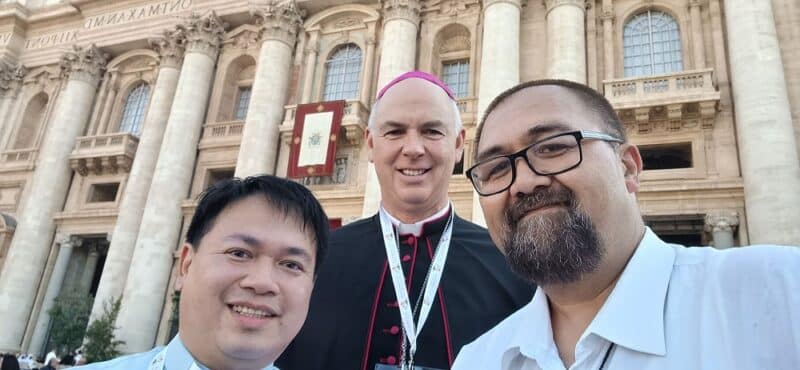The recently concluded first phase of the Synod on Synodality brought to the fore the wide diversity within the Church unified by faith, as well as the need to reclaim the early Church’s identity through synodality.
Wellington Archbishop Paul Martin, SM, Fr Dennis Nacorda and Auckland Vicar for Maori Manuel Beazley, represented the New Zealand Catholic Church at the synod held in Rome in October.
The synod was attended by 350 delegates, 270 of whom were cardinals and bishops, with the others being lay people, religious and priests.
“This was an opportunity to see how we as a Church can be more authentic in our living of the Gospel, and how our structures can help us to do this in the age in which we live,” Archbishop Martin said in a newsletter dated November 7.
Fr Nacorda, parish priest of St Joseph’s in Levin, described synodality in the words of St Augustine as something “so ancient and so new”.
“The early Church lived synodal spirituality as they discerned on issues affecting their communities, yet I found it something new, unique, and revolutionary. How did we lose this excellent way of being Church?” he said.
Common bond
Mr Beazley said that, though the delegates were strangers at the beginning, “there was a common bond between us”.
“There is probably no other institution on earth that could have done this, to bring 400 or so people from all over the world from very, very different experiences and diversity of culture and language, but we were held together by some common purpose,” he said.
The diversity meant that the challenges facing the Church in each part of the world are different.
“Being with so many people from around the world was a reminder that the Church is much bigger than just our country or diocese; that the challenges we face are not the same as those for other places, and yet we are all united in this one Church,” reflected Archbishop Martin.
The three representatives admitted that there were differences in opinions, as evidenced by the fact that not one of the sections of the synod’s Letter to the People of God passed unanimously.
Some of the more contentious issues around ordination of women, priestly celibacy, as well as clerical abuse, had more negative votes than others.
“We may have agreed on certain things and disagreed on others, but we felt the spirit of respect and reverence,” Fr Nacorda said.
Archbishop Martin noted, “there was a positive sense of wanting to work through these and a willingness to talk about them, which is not to be taken for granted”.
Silence and prayer
Silence and prayer are features of this synod that the three representatives deeply appreciated.
“One of the powerful experiences of the Synod was the use of spiritual conversations in the Spirit. There was a lot of listening to do, but we stopped very regularly to pray for three minutes at a time, on what we had heard and to discern what the Holy Spirit was saying. It kept our conversations in the realm of faith, as well as discussion and ideas. It is not the only way of operating in these sorts of meetings, but it is a powerful way of allowing the Holy Spirit to work,” said Archbishop Martin.
Mr Beazley explained how the “conversations in the Spirit” worked. Ten to 12 people were seated in each of the round tables set up at the Paul VI hall, as they worked through the Instrumentum Laboris (working document), which had fifteen worksheets. Each person in the group would have three to four minutes to respond to the question before them and after two or three speakers, the group would pause for silence and prayer. This was the first round of discussions.
Fr Nacorda found this method inspiring.
“Synodal spirituality, especially the conversation in the Spirit, is the best way for the Church to move forward, letting it penetrate all the spheres of the Church – from the ministry groups to parish to diocese, to conferences, to Roman Curia, and the whole universal Church,” he said.
“Synodality is like the pneuma that animates the Church, as it defines the specific modus vivendi et operandi of the Church. It is like blood that penetrates even the farthest, minutest, and most challenging parts of the Church, to revitalise them with life-giving nutrients.”
In the second round, the participants were asked to highlight a point that they heard someone else say, while the third round saw a call for a group discussion that would lead into the construction of a group report.
Each report was presented to the assembly. All the reports were synthesised by the secretariat. Lastly, they voted on the report presented by the secretariat to the assembly.
Mr Beazley said that this synod will probably be the model for future synods.
“Overwhelmingly, the participants, including the bishops and cardinals, voted in favour of future synods retaining that style . . . where we’re seated at round tables, talking to each other, looking at each other,” he said. “Whether or not non-bishop members will continue to be invited to these synods remains to be seen.”
The three synod delegates were invited to speak to the priests in Auckland and Palmerston North on their experiences.

Reader Interactions